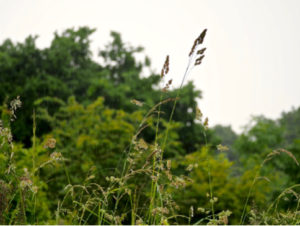This is the first in a series of reflections on our expedition to Lodge Hill, from poet, writer and broadcaster Paul Evans.

Cocksfoot
Photograph by Maria Nunzia @Varvera
Between downpours the security guard goes behind the building for a cigarette. Beside him is a fire-bucket of sand in which a thousand stub ends from countless shifts have been placed. We are admiring the yellow brick Victorian building across the road which he tells me used to be a railway station and the road a narrow-gauge track. He points out the cast-iron ventilation grills in its walls and compares them to the plastic vents in the security building. There is something cheap and mean about the vents in his building, something that symbolises the unreadiness of our own time to face the future and a regret that the resilient qualities inherent in historical architecture are missing. Buildings used to be built to last a long time and when they needed repairing it was a straightforward matter, he says, and mentions Westminster Abbey: a building continually renewed by traditional means for centuries. Not now.
We are a few days away from the Euro referendum, we look as if we may hold opposing views on this and many other things but we are both peering through the rain at a dissolving world. His job is to prevent entry to abandoned buildings – ruins. My job is to celebrate the weeds and wildlife that are taking over. In the office he has a ring-binder full of pictures of army ordnance still scattered around the site – grenades, shells, mortars, bullets – which he read to me like a natural history field guide to a military past. He finishes his cigarette, adds the butt to the fire-bucket collection and returns to his duties. I, on the other hand, am drawn up the road-once-railway by the songs of thrushes, blackcaps and nightingales falling into wet grass to resume mine.
Paul Evans, Lodge Hill, 17 June 2016
Paul’s website is www.paulevanswenlockedge.com

Comments are closed.